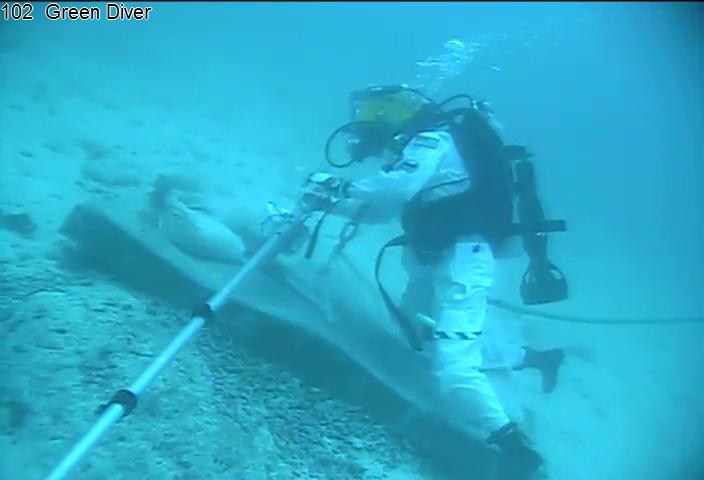
Image at right: Steve Squyres of Cornell uses a small boom for translation activities.
Today was Day 4 of our mission and it was a challenging one. As usual,the action was centered around the “EVAs”, or extra-vehicular activities inNASA parlance – our simulated space walks.
We had two different kinds of activities in today’s EVAs. One of themwas very slow, very methodical, and very effective. Imagine a long telescopingpole – we called it a boom – with big heavy magnets on each end. We used thisboom to get around on the simulated asteroid surface (i.e., the sea floor),moving like an inchworm.
It goes like this: Fasten both magnets to anchor points on the surface.Unfasten one and move to it to a new anchor point. Fasten it. Unfasten theother one and move it to a new anchor point… and repeat as necessary. It wasslow, but it got us to where we wanted to go pretty reliably.
Once we arrived at our destination, the boom was great. It’s hard to dothings like hit a rock with a hammer in zero-g without going flying. But withthe boom solidly in place, we could wrap our legs around it and whack away atthe rock pretty easily. So a boom could be a good technique for geologists touse to get work done on an asteroid, I think.
The other part of the EVA was totally different… jet packs! We hadbattery-powered thruster packs on our backs that we could use to move veryquickly and easily from one place to another. And yeah, I have to confess, itwas every bit as much fun as it sounds like it was. Quick, easy, and very cool.Problem was, once we arrived at our destination with ajob to do, staying in place was a lot harder.
Sometimes the best answer to a complicated problem is to use somecombination of techniques. So one way I could see this going might be thatastronauts would use jet packs to move long distances over an asteroid surface,and then a boom for smaller motions and getting work done.
Or maybe they’ll use something completely different! It’s only Day 4 ofthe mission, and we’ve got a lot more techniques to try… so we’ll see.

It sounds really amazing.
By the way, how deep is the place where you make your tests?
Thanks for share you experience with all of us!
Regards!
PS: Is there some kind of technical information available on any website about what you are doing? (I mean about your facilities)
It sounds really amazing.
By the way, how deep is the place where you make your tests?
Thanks for share you experience with all of us!
Regards!
PS: Is there some kind of technical information available on any website about what you are doing? (I mean about your facilities)
Hi Franscisco,
The testing takes place approximately 62 feet below the surface, although the gradation of the sea floor tends to make that fluctuate.
You can find more technical details on the NEEMO 15 Web page:
https://www.nasa.gov/mission_pages/NEEMO/NEEMO15/index.html.
Thanks for following!
During my last few years with the US Navy I was part of a mission that trained dolphins to attach tracking devices to targets, and our training was very similar to what is happening here. In fact, our instructors at the time told us that our training was similar to EVA training that astronauts go through, although I think at the time we didn’t pay much attention to that.
However, I can see now that other groups besides the US military receive very specialized (and intense!) underwater training.
Thanks for the post, I’ll keep following this!
Russ Hudson
Editor-in-Chief
http://www.contentforconversions.com
Couldn’t the “jet packs” be thrusting upwards to provide artificial gravity, or at least to increase ground effect?
Hey you guys at Nasa have the right stuff and great work with those extreme environment testing and training. Its all worth it for future space exploration. Thanks for sharing this information Aloha !
Why can’t you do what mountain climbers do here on Earth! These people use hammers to repeatedly pound spikes into rocks and pull themselves up that way! Slowly but surely they scale shear cliffs etc.
I’ve never heard Earth mountain climbers complain about rock pieces hitting their eyes, or anything. Sometimes with the rock climbers a spike becomes loose, and they replace it with a new one.
Wouldn’t it be easier for astronauts to transition from rock climbing and training with spikes instead of learning totally new and untried tools.
Also for an icey or snowy astroid, astronauts could use snow shoes, skies, etc with their booms and jets.
What about wearing special shoes and gloves, maybe with some sort of spikes.
If the astroid is hard, what about anchoring a rope at two ends. The rope could be tighened-up some how. The astronauts could then crawl and pull theirselves along the rope.
They could shoot the astroid with the two ends of the rope.